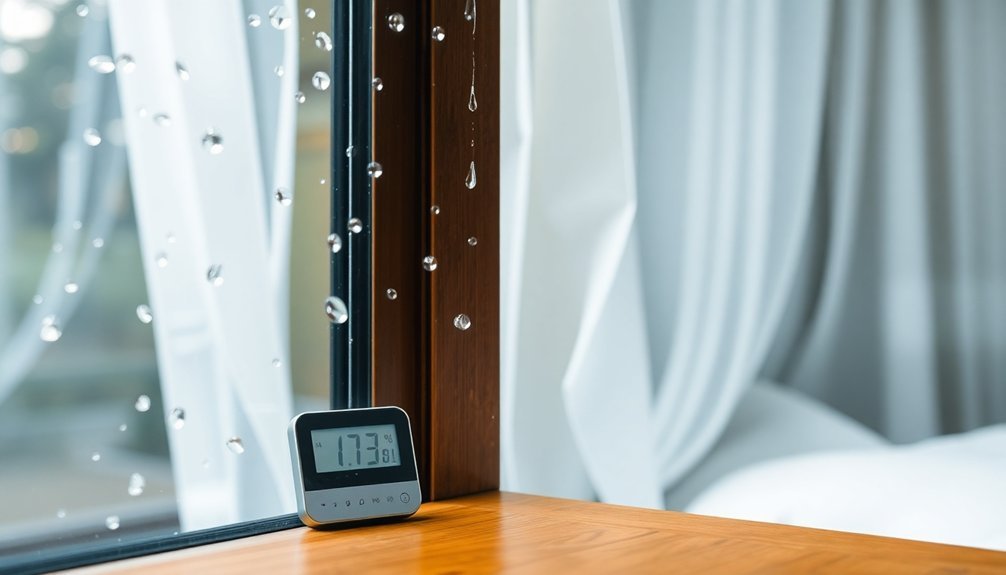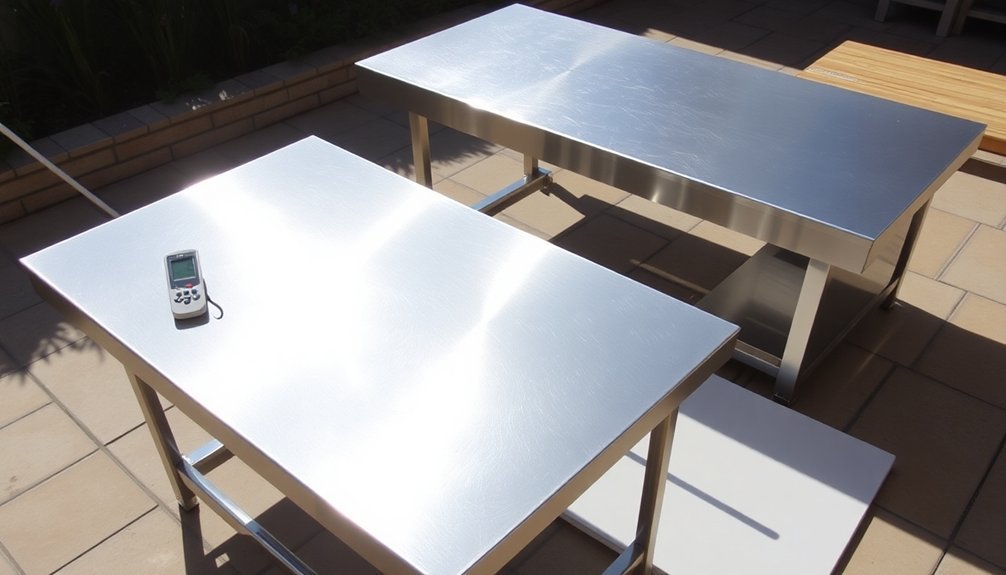To effectively control moisture while drying, you'll need to monitor relative humidity levels closely, aiming for 45-55%. Position your solar dryers strategically facing south and on elevated ground for maximum exposure. Create continuous airflow patterns with properly spaced air movers at 45-degree angles. Control temperatures carefully during peak hours, starting low and gradually increasing. Space food items in single layers with 1-2 inches between pieces. Rotate drying trays regularly for even exposure, and utilize natural desiccants like silica gel or activated charcoal. Install ventilation screens and check weather conditions daily. These fundamental techniques mark just the beginning of mastering moisture control.
Monitor Relative Humidity Levels

Proper humidity monitoring serves as the foundation for successful drying processes. You'll need to maintain relative humidity levels between 45% and 55% for ideal drying, as levels outside this range can cause significant problems.
When humidity exceeds 55%, you're risking slower drying times and potential mold growth, while levels below 45% can lead to materials drying too quickly and becoming brittle.
To effectively monitor humidity, you'll want to invest in reliable measurement tools. Start with a quality hygrometer or digital humidity meter, which you can find at most hardware stores. Daily moisture inspections help identify any potential issues before they become serious problems.
For more detailed tracking, consider using data loggers that record humidity levels over time. Place these devices strategically throughout your drying area to guarantee accurate readings.
You can control humidity levels by using dehumidifiers when they're too high or humidifiers when they're too low. Proper air circulation is vital, so incorporate fans or ventilation systems to maintain consistent levels.
Remember to regularly check and document your readings, making adjustments as needed. By maintaining proper humidity control, you're protecting your materials from damage while guaranteeing ideal drying conditions.
Position Solar Dryers Strategically
Beyond monitoring humidity levels, the strategic positioning of your solar dryer will determine its effectiveness. You'll want to select a location that maximizes sun exposure while minimizing ambient moisture interference. Consider areas with consistently high solar radiation and low relative humidity to guarantee ideal drying conditions. Natural convection systems are becoming increasingly popular, projected to capture 61% of revenue share by 2037.
For the best results, follow these essential positioning guidelines:
- Orient your dryer to capture maximum sunlight throughout the day, typically facing south in the Northern Hemisphere to enhance solar radiation exposure.
- Choose elevated ground with good airflow to promote natural convection and prevent moisture accumulation around the base.
- Install the dryer away from tall structures, trees, or obstacles that could cast shadows or block air movement.
- Place your unit in an area where you've conducted performance trials to confirm site-specific effectiveness.
If you're using a natural convection system like a tent or box dryer, proper positioning becomes even more significant since these rely entirely on buoyancy forces for air circulation.
You'll also want to use locally available materials for construction, making maintenance and repairs more manageable while keeping costs down.
Optimize Airflow Circulation

You'll need to place air movers strategically to create a continuous flow pattern that maximizes moisture removal from your drying space.
Position these devices to direct airflow across wet surfaces while ensuring the air can freely circulate between affected areas without creating dead spots or zones of stagnant air. Consistent circulation helps achieve more uniform drying results throughout the entire affected space.
Strategic Air Mover Placement
Strategic placement of air movers serves as the cornerstone of effective moisture control during drying operations. You'll achieve ideal results by positioning your units at a 45-degree angle to walls and wet surfaces, creating a circular airflow pattern that maximizes drying efficiency.
When working in larger spaces, space your air movers 10-15 feet apart while ensuring slight overlap in coverage areas.
For the most effective moisture control, follow these essential placement strategies:
- Direct airflow upward when drying vertical surfaces, and aim specifically toward corners and hard-to-reach areas.
- Keep air movers at least six inches away from walls and obstacles to maintain proper circulation.
- Position units around the room's perimeter, ensuring thorough coverage of the entire space.
- Select the appropriate air mover type based on your specific task – low-profile units for carpets, axial fans for open areas, and snail fans for corners.
Monitor humidity levels continuously and adjust your air movers' positions as conditions change.
You'll want to maintain consistent circulation while increasing temperature moderately to speed up evaporation. Remember to avoid excessive heat that could damage materials during the drying process.
Ventilation Zone Management
Managing ventilation zones effectively requires creating distinct airflow patterns that enhance moisture removal throughout your drying space.
You'll need to establish continuous air circulation between affected areas while guaranteeing fresh air intake and moisture expulsion through proper ventilation points.
To maximize your ventilation zones, you'll want to remove furniture from wall corners and create clear pathways for air movement.
Set up your blowers strategically, as they're markedly more efficient than traditional fans, which lose up to 90% of their effectiveness when drying multiple items.
Implement a structured air barrier system and seal all penetrations to maintain controlled airflow patterns.
Monitor your ventilation zones in real-time using systems like the Airflow Enhancer to maintain ideal exhaust balance.
You'll achieve faster drying times by managing the HAT principles – heat, airflow, and temperature.
Increase your drying efficiency by using blowers with higher CFM ratings and position dehumidifiers in strategic locations to accelerate moisture removal.
Remember to maintain proper ducting without restrictions and manage backpressure to prevent efficiency losses.
This integrated approach guarantees uniform drying throughout your space while minimizing energy consumption.
Control Temperature During Peak Hours
Controlling temperature during peak drying hours calls for a systematic approach based on predetermined kiln schedules and real-time monitoring.
You'll need to carefully manage temperature settings to maintain ideal drying conditions while preventing wood stress and potential defects. By leveraging automated systems and real-time moisture monitoring, you can make precise adjustments that keep your drying process on track.
During peak hours, you'll want to focus on these critical temperature control strategies:
- Start with lower temperatures during initial conditioning to protect the wood's integrity, then gradually increase them as the wood begins releasing moisture.
- Monitor vapor pressure changes and adjust temperatures accordingly to facilitate consistent moisture release without causing sudden stress.
- Use automated controllers to maintain temperature stability, especially when air velocity fluctuations threaten to disrupt your target settings.
- Implement real-time data monitoring to make informed temperature adjustments that prevent over-drying while maintaining efficient moisture removal.
Remember that higher temperatures will increase evaporation rates and lower relative humidity, but you'll need to balance these effects carefully to avoid cracking or splitting in your wood materials.
Space Food Items Properly

You'll want to strategically place your food items with enough space between them to guarantee proper air circulation throughout the drying process.
Don't overlap or stack food pieces, as this can trap moisture and lead to uneven drying times.
Arrange everything in a single layer, leaving small gaps between pieces to maximize airflow and achieve consistent results.
Strategic Placement For Airflow
Proper spacing is crucial when arranging food items for drying. You'll want to create an environment where air can flow freely around each piece, preventing moisture from becoming trapped and potentially causing spoilage. By strategically positioning your items, you're maximizing the efficiency of your drying system while guaranteeing consistent results.
- Position your food items with at least 1-2 inches of space between them to allow for proper air circulation and prevent cross-contamination between areas with different moisture levels.
- Keep items elevated above surfaces using racks or screens that won't trap moisture, allowing air to flow both above and below.
- Arrange items so they're directly in the path of your ventilation system's airflow, but not blocking air intakes or exhaust points.
- Create zones within your drying area where you can maintain different pressure levels, keeping cleaner areas at higher positive pressure.
Remember to keep your drying surfaces clean and dry to prevent additional moisture from evaporating into the air.
If you're using multiple drying racks, stagger their placement to guarantee ideal airflow patterns and prevent any dead spots where moisture might accumulate.
Avoid Overlapping Food Items
Beyond strategic placement, the specific spacing between individual food items plays an essential role in successful dehydration. When you overlap food pieces during drying, you're risking uneven moisture distribution and creating potential hotspots for bacterial growth. To prevent these issues, you'll want to leave adequate gaps between each piece, allowing air to circulate freely around all surfaces.
You'll achieve the best results by cutting your food into uniform pieces and arranging them on drying racks or trays with consistent spacing. Don't let pieces touch each other, as this can lead to moisture reabsorption and increase the risk of mold growth.
If you're using a dehydrator with multiple trays, make sure to rotate them periodically to guarantee even drying throughout the process.
Keep in mind that proper spacing isn't just about preventing spoilage – it's also vital for maintaining food quality. When you space items correctly, you'll preserve more nutrients, achieve better texture, and end up with a more visually appealing final product.
Use specialized equipment like drying screens or dehydrator trays to maintain consistent spacing throughout the entire drying process.
Single Layer Drying Method
Starting with a well-prepared single layer guarantees perfect moisture control throughout the drying process.
You'll need to arrange your food items carefully on trays or screens that allow air circulation both above and below. Make certain there's no contact between individual pieces, as this prevents moisture from transferring and guarantees uniform drying throughout.
To achieve peak results with the single layer method, follow these essential steps:
- Cut all food items into uniform sizes and pretreat them appropriately – blanch vegetables to maintain color and pretreat fruits to enhance drying quality.
- Place your prepared items on drying surfaces with enough space between pieces to allow air to flow freely around each one.
- Position your trays with adequate spacing between them, guaranteeing proper air circulation throughout the drying area.
- Cover your food with cheesecloth or screens to protect it from insects while maintaining airflow.
Maintain a temperature of around 140°F and keep humidity levels low throughout the process.
You'll want to check your items regularly for dryness, testing multiple pieces to guarantee they're drying evenly. Once dried, cool your food quickly and store it in airtight containers in a cool, dark place.
Use Moisture-Wicking Materials
Moisture-wicking materials serve as your first line of defense against excess moisture during the drying process. These specialized fabrics utilize capillary action to transport moisture from one surface to another without requiring external force.
When you're working with drying applications, you'll want to take advantage of synthetic materials like polyester and nylon, which naturally repel water and enhance the wicking performance.
To maximize the effectiveness of moisture-wicking materials, you'll need to pay attention to their structure and maintenance. Look for fabrics with engineered yarn structures that create small channels for moisture movement.
If you're using cotton-based materials, make sure they're treated with moisture-wicking technologies like TransDRY® to achieve similar performance to synthetics.
You'll need to maintain these materials properly to preserve their moisture-wicking capabilities. Don't use fabric softeners, as they'll leave a waxy coating that interferes with the wicking action.
Wash your moisture-wicking materials in cold water and dry them on low heat. By following the care instructions carefully, you'll guarantee that the fabric's molecular forces continue to effectively move moisture through the material's porous structure, maintaining ideal drying performance.
Rotate Drying Trays Regularly

Rotating your drying trays regularly helps create ideal airflow patterns that reach every corner of your materials.
You'll want to check different zones within your drying setup to identify areas where moisture might be collecting and adjust your rotation schedule accordingly.
Maximize Airflow Distribution Patterns
Proper airflow distribution can make or break your drying process, and rotating trays play an essential role in achieving ideal results. When you maintain consistent tray rotation at around 6 rounds per minute, you'll guarantee uniform exposure to heat and airflow throughout your materials.
Multiple inlet points for hot air, combined with strategic vent placement, create a superior drying environment that considerably reduces moisture fluctuation.
To maximize your dryer's efficiency, focus on these critical airflow distribution elements:
- Position hot air entries in a 30:30:40 ratio (upper, middle, and lower) to achieve even heat distribution and consistent drying across all layers.
- Keep vents and ducts clean and unobstructed to maintain strong airflow – blocked vents will dramatically increase drying times.
- Install a powerful fan that's appropriately sized for your drying chamber to guarantee hot air reaches all areas effectively.
- Monitor your tray rotation speed and maintain it consistently – stationary or irregularly rotating trays will result in uneven drying.
You'll achieve better drying outcomes by implementing these airflow enhancement strategies, especially when combined with proper chamber design and regular maintenance of your ventilation system.
Check Moisture Level Zones
Your dryer's success hinges on maintaining consistent moisture levels across all zones, making regular tray rotation vital. By rotating your drying trays, you'll guarantee even distribution of heat and air, preventing moisture from accumulating in specific areas, especially the lower trays. You'll want to pay close attention to the multiple inlet points, as they play an essential role in achieving uniform evaporation rates.
Monitor your moisture levels using the MAC125 analyzer and adjust your rotation schedule accordingly. You'll notice that maintaining proper temperature ranges between 70-90°F greatly impacts your drying efficiency. Remember that surface temperatures typically run 20-25°F lower than ambient conditions.
| Zone Location | Key Checks | Action Required |
|---|---|---|
| Upper Zone | Air Flow Rate | Adjust 30% inlet flow |
| Middle Zone | Temperature | Maintain 70-90°F range |
| Lower Zone | Moisture Level | Increase 40% air flow |
Keep your door seals tight using high-temperature resistant elastic rubber strips to prevent moisture escape. Check your chamber's insulation regularly and use butterfly valves to control air flow through wall-side tubes for ideal drying conditions. You'll find that consistent monitoring and adjustment of these factors leads to superior drying results.
Prevent Cold Spot Formation
Three critical factors contribute to cold spot prevention in your drying process: consistent heat distribution, strategic tray placement, and regular rotation schedules.
You'll need to maintain uniform temperatures throughout your drying area while guaranteeing proper airflow around your items to prevent moisture from settling in cooler zones.
To effectively prevent cold spots during the drying process:
- Keep furniture and drying racks at least 50cm away from external walls, allowing warm air to circulate freely and prevent moisture accumulation in cooler areas.
- Remove any obstructions around heat sources and confirm your thermostatic controls are set uniformly to maintain consistent temperatures throughout the space.
- Use cross ventilation by opening windows on opposite sides of the room, creating a steady airflow that helps eliminate stagnant, cool air pockets.
- Position your drying racks strategically to avoid overcrowding, which can create dead zones where cold air gets trapped.
Remember to check your drying areas regularly for signs of condensation or dampness.
If you notice any cold spots forming, adjust your layout immediately and increase ventilation in that specific area.
Don't block air vents or trickle ventilators, as they're essential for maintaining proper air circulation and temperature consistency.
Install Ventilation Screens
Installing ventilation screens stands as a critical step in managing moisture within your building's structure. You'll need to guarantee proper drainage and ventilation through components that direct water away from insulation and framing while promoting air circulation.
| Feature | Benefit |
|---|---|
| Top Vent Track | Allows vapor escape and secure connections |
| Drip Flashing | Facilitates bottom drainage effectively |
| Polypropylene Mesh | Provides 95% open design for airflow |
When installing ventilation screens, you'll need to take into account your specific climate conditions and adapt the installation accordingly. It's crucial to integrate these screens with your existing wall assembly and verify they're compatible with other moisture control measures like house wraps and insulation.
You'll want to maintain regular inspections of your ventilation screen system to prevent blockages and guarantee peak performance. Pay special attention to ground sloping near foundations and include polyethylene ground covers in crawlspaces for thorough moisture control. By properly installing and maintaining ventilation screens, you'll reduce mold growth potential, enhance your building's structural integrity, and improve overall energy efficiency through effective moisture management.
Check Weather Conditions Daily

Beyond proper ventilation screens, daily weather monitoring plays a central role in effective moisture control.
You'll need to understand how weather patterns affect your drying process, as temperature, humidity, and dew point directly impact moisture removal efficiency. By checking weather conditions regularly, you can adjust your drying parameters for ideal results.
1. Monitor the relative humidity closely – when it's lower, you'll achieve faster drying rates.
Remember that your grain's equilibrium moisture content can't drop below what the ambient conditions allow, so timing your drying during low-humidity periods is essential.
2. Track the dew point temperature – it's your best indicator of actual moisture content in the air.
If temperatures fall below the dew point, you'll face condensation issues that can severely hamper drying efficiency.
3. Watch air temperature forecasts – higher temperatures boost moisture removal capacity.
You can adjust your drying schedule to take advantage of warmer periods.
4. Pay attention to air flow conditions – wind speeds and direction affect ventilation effectiveness.
You'll want to enhance your drying setup based on predicted air movement patterns, ensuring consistent moisture removal throughout the process.
Apply Natural Desiccants
Natural desiccants offer a powerful yet eco-friendly solution for controlling moisture during the drying process. You'll find several effective options that won't harm the environment or your health.
Silica gel leads the pack, absorbing up to 40% of its weight in moisture, and you can reuse it by simply heating it when saturated. For food-safe applications, activated charcoal works exceptionally well, pulling in both moisture and unwanted odors.
If you're looking for readily available options, you can use rice or baking soda from your kitchen. While rice isn't as efficient as commercial desiccants, it's perfect for small-scale applications like rescuing wet electronics.
Bentonite and montmorillonite clays provide excellent alternatives when you need serious moisture control, and they're both reusable and cost-effective.
To maximize effectiveness, place your chosen desiccant in strategic locations where moisture tends to accumulate. You'll want to check and replace or reactivate them regularly, especially in high-humidity conditions.
Remember that while salt is an option, you should avoid it when working with metal surfaces due to its corrosive properties. Instead, opt for non-corrosive alternatives like silica gel or activated charcoal.
Frequently Asked Questions
How Long Can Dried Items Be Stored Before Quality Deterioration Begins?
You'll get 6-12 months of shelf life for dried items in your pantry. If you refrigerate them, they'll last 1-2 years, and freezing extends storage to 3+ years before quality drops.
What Emergency Backup Methods Exist When Mechanical Drying Systems Fail?
You can rely on diesel generators, fossil fuel backup boilers, or solar bubble dryers when mechanical systems fail. You'll also want parallel generator systems and redundant components to prevent complete operational shutdowns.
Can Different Materials Be Dried Simultaneously Without Affecting Each Other?
Yes, you can dry different materials simultaneously using hybrid drying technology. The Smart3D Multimaterial Dryer lets you safely dry PVA, Nylon, and TPU at once while maintaining their individual drying requirements.
How Do Altitude and Atmospheric Pressure Impact Drying Time and Efficiency?
At higher altitudes, you'll experience slower drying times due to lower air pressure, which affects evaporation rates. You'll need to adjust temperature settings and drying duration to maintain efficiency in your drying process.
What Signs Indicate Over-Drying Has Occurred in Various Materials?
You'll notice color changes, cracking, and stiffness in over-dried materials. Watch for warping in wood, discoloration in plastics, and rigidity in fabrics. These signs indicate you've removed too much moisture.
In Summary
You've now learned key strategies to master moisture control in your drying process. By monitoring humidity, optimizing placement and airflow, and staying attentive to weather conditions, you'll achieve better results. Don't forget to rotate your trays and use proper spacing. With these expert techniques, you can prevent moisture-related issues and produce consistently high-quality dried goods for your needs.





Leave a Reply